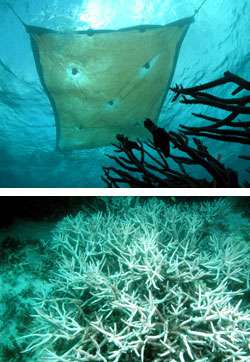Researchers working to prevent a coral bleaching catastrophe

Researchers at The University of Queensland are racing against time to lessen the damage from a coral bleaching incident about to hit the Great Barrier Reef.
The Director of UQ's Centre for Marine Studies, Professor Ove Hoegh-Guldberg, has warned that between 30 to 40 percent of coral on Queensland's Great Barrier Reef could die within a month due to 2005's record temperatures.
Professor Hoegh-Guldberg said his team was working on several projects to prevent bleaching, including placing shades above corals during summer. But he said there was little that could be done in the short term to prevent an incident during the coming weeks.
“Bleaching events usually occur about four to six weeks after the high temperature anomalies begin. They can turn white overnight across hundreds of square kilometres of reef,” he said.
“The last six major bleaching events, which started for the first time in 1979, were caused by high sea temperature anomalies. This year the Great Barrier Reef seas have been exceptionally warm.”
“In 2002, 60 percent of the Great Barrier Reef bleached, after which, five to 10 percent died. This year we are worried because we have higher anomalies, which may result in greater damage.”
UQ researchers are part of what has become known as the “Shade Project”, which involves gazebo-sized shades being placed above corals during the summer months.
Professor Hoegh-Guldberg, who is working with the CRC Reef Research Centre, the Australian Institute of Marine Science and Quicksilver Connections, said early results were very promising.
The idea is to reduce the stress from the light just enough so that the reef doesn't change due to the effect of low light, but enough so that more corals survive the warmer periods.
“Laboratory results have shown that reducing light during thermal stress reduces the amount of damage done. Less light and more corals survive periods of warm water,” he said.
“Adding just 50 percent shade reduces the light stress on the corals below while not changing too much else.”
The next step will be to see how the shades operate in the imminent bleaching event.
“If they do as we think they will, the shades could preserve small patches of coral, which is important for people who want to see coral but also to maintain a critical oasis for the future,” he said.
“These saved areas might also be important for providing stock to replenish affected reefs outside the shaded areas.”
The corals responsible for building coral reefs are symbiotic with tiny dinoflagellate algae. These tiny cells populate the tissues of corals, turning them brown.
When stressed by high temperatures or light, the symbiosis between coral and dinoflagellate breaks down and the brown dinoflagellates leave, turning the coral bright white. Without the dinoflagellates, the corals can die in great numbers.
Professor Hoegh-Guldberg and his team are currently posted at UQ's Heron Island Research Station where they are setting up long-term monitoring strategies to examine the effect of the predicted bleaching event and others that are likely to take place over the next 20 years.
The researchers are also collecting samples to try and understand the molecular basis of distress in corals. They are hoping to find out why some corals are more tolerant than others.
“By reducing the cause and by implementing better reef management it is possible to reverse the damage,” he said.
“Ultimately, we have to rapidly reduce the rate of global warming by reducing carbon dioxide emissions.
“At the same time, we need to recognise that reefs will be extremely fragile over the next few decades as we try to get this problem under control. This is a fragile patient that needs all the care it can get.”
Source: University of Queensland
















